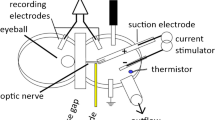Summary
1. Growth cones of cultured dorsal root ganglion neurons from mice were irradiated using a mercury lamp.
2. The flux of particles of fast retrograde axoplasmic transport decreased promptly after light irradiation without a change in velocity.
3. That of anterograde transport decreased as well, but with a significant latency. The decrease in the anterograde flux was attributed to decreased velocity of particles.
4. Video-enhanced contrast microscopy of growth cones revealed transient swelling of growth cones and transient stagnation of particles in growth cones.
5. The longer the neurite, the larger the latency of the change of the anterograde transport; peripheral information was calculated to be conveyed to the cell body at a speed of 6 µm/min.
6. The mechanism of this information conveyance and the export of materials from the cell body are discussed.
Similar content being viewed by others
References
Allen, R. D., and Allen, N. S. (1983). Video-enhanced microscopy with a computer frame memory.J. Microsc. 1293–17.
Allen, R. D., Metuzals, J., Tasaki, I., Brady, S. T., and Gilbert, S. P. (1982). Fast axonal transport in squid giant axon.Science 2181127–1129.
Breuer, A. C., Allen, R. D., and Lewis, L. J. (1981). Rapid transport in neurites of “submicroscopic” structures: Analysis by the new AVEC-DIC microscopy method.Neurology 31118.
Campenot, R. B. (1977). Local control of neurite development by nerve growth factor.Proc. Natl. Acad. Sci. USA 744516–4519.
Davies, A., and Lumsden, A. (1984). Relation of target encounter and neuronal death to nerve growth factor responsiveness in the developing mouse trigeminal ganglion.J. Comp. Neurol. 223124–137.
Esquerro, E., Garcia, A. G., and Sanches-Garcia, P. (1980). The effects of the calcium ionophore, A23187, on the axoplasmic transport of dopamine beta-hydroxylase.Br. J. Pharmacol. 70375–381.
Forman, D. S., Brown, K. J., and Promersberger, M. E. (1983). Selective inhibition of retrograde axonal transport by erythro-9-[3-(2-hydroxynonyl)] adenine.Brain Res. 272194–197.
Forman, D. S., Lynch, K. J., and Smith, R. S. (1987). Organella dynamcis in lobster axons: Anterograde, retrograde and stationary mitochondria.Brain Res. 41296–106.
Inoue, S. (1986).Video Microscopy, New York, Plenum Press, pp. 1–529.
Jeffrey, P. I., James, K. A. C., Kidman, A. D., Richard, A. M., and Austin, L. (1972). The flow of mitochondria in chicken sciatic nerve.J. Neurobiol. 3199–208.
Kawakami, T., Hikawa, N., Kusakabe, T., Kano, M., Bandou, Y., Gotoh, H., and Takenaka, T. (1993). Mechanism of inhibitory action of capsaicin on particulate axoplasmic transport in sensory neurons in culture.J. Neurobiol. 24545–551.
LaVail, J. H., and LaVail, M. M. (1972). Retrograde axonal transport in the central nervous system.Science 1761416–1417.
Martenson, C., Stone, K., Reedy, M., and Sheetz, M. (1993). Fast axonal transport is required for growth cone advance.Nature 36666–69.
Ochs, S. (1982).Axoplasmic Transport and Its Relation to Other Nerve Functions, John Wiley & Sons, New York, pp. 1–462.
Ochs, S., and Smith, C. (1971). Effect of temperature and rate of stimulation on fast axoplasmic transport in mammalian nerve fibers.Fed. Proc. 30665.
Sommer, E. W., Kazimierczak, J., and Droz, B. (1985). Neuronal subpopulations in the dorsal root ganglion of the mouse as characterized by combination of ultrastructural and cytochemical features.Brain Res. 346310–326.
Takenaka, T., Kawakami, T., Hikawa, N., and Gotoh, H. (1990). Axoplasmic transport of mitochondria in cultured dorsal root ganglion cells.Brain Res. 346285–290.
Tsukita, S., and Ishikawa, H. (1980). The movement of membranous organelles in axons. Electron microscopic identification of anterogradely and retrogradely transported organelles.J. Cell Biol. 84513–530.
Worth, R. M., and Ochs, S. (1976). The effects of repetitive electrical stimulation on axoplasmic transport.Soc. Neurosci. Abstr. 250.
Author information
Authors and Affiliations
Rights and permissions
About this article
Cite this article
Kano, M., Tashiro, H., Kawakami, T. et al. Differential suppression of axoplasmic transport: Effects of light irradiation to the growth cone of cultured dorsal root ganglion neurons. Cell Mol Neurobiol 15, 297–306 (1995). https://doi.org/10.1007/BF02089941
Received:
Accepted:
Issue Date:
DOI: https://doi.org/10.1007/BF02089941




